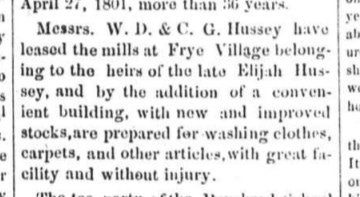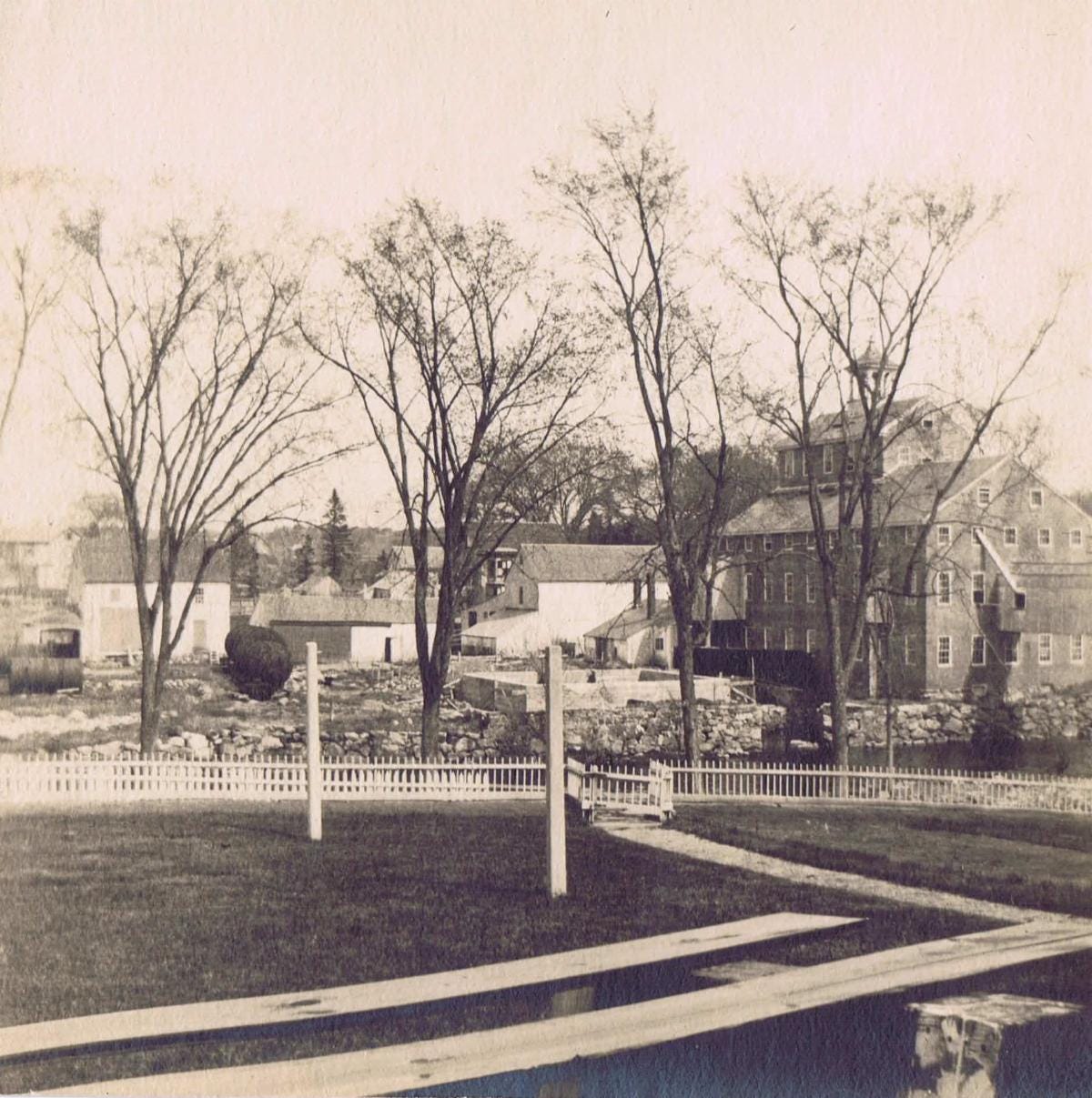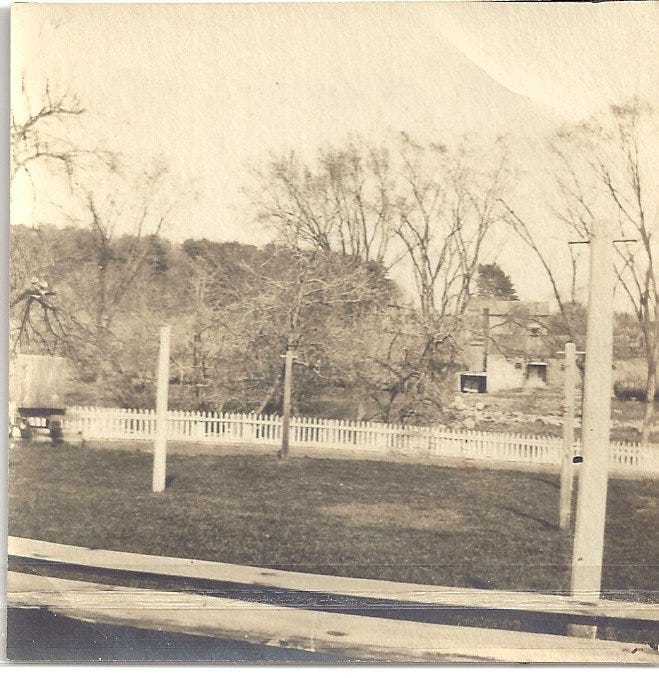Before Shawsheen Village Frye Village Stories: uncovering the story of “Andover’s famous laundry stocks”
We ended last week’s story with an Andover Townsman article from 1894:
“The Andover and Lawrence Express, in connection with its regular business, will on Sunday evenings make a trip to the stocks in Frye Village with washings and return them on Monday morning. The proprietor will be pleased to attend all orders left at the Park Street office. The first trip will be made next Sunday evening.”
This was the second newspaper reference I found referring to the Frye Village laundry operation as “stocks.” The first was in 1870 when the Husseys built their washing operation.
Andover Advertiser, January 21, 1870
There’s a local story about Andover’s “famous laundry stocks” that I've been looking into.
The story can be traced first to an October 20, 1955 article in the Andover Townsman titled “First flax mill was located here.”
“It was in this area between Hussey’s pond and the river that the famous Andover Stocks were located. The Stocks were Andover’s early version of a wet-wash laundry. Any time after three o’clock on a Sunday afternoon, the roads would be well traveled with people from Andover and Lawrence pulling wagons filled with clothes and even carrying tubs of clothes on their shoulders, all on their way to the community out-door laundry. Washing was not allowed on the Sabbath but one minute after midnight the scrubbing began and continued through the night until Monday noon.”
Digging deeper, the 1955 article was based on “Sketches of Frye Village Life” by Alice Morrison Bell (1879-1949). The full text of “Sketches of Frye Village Life” is in the files of the History Center.
“The Stocks was Andover’s wet wash laundry. After 3 o’clock on a Sunday afternoon, all roads led to the Stocks. There were wagons from Lawrence and Andover filled with baskets and tubs of clothes, even with carts and wheel barrows, yes even carrying a tub of clothes on their shoulder – on their way to the Stocks. At one minute after midnight the work began and washing went on through the night and usually until Monday noon.”
Alice Morrison Bell was born in Frye Village to John W. and Helen Morrison Bell. The family lived on Haverhill Street. John was a bookkeeper and then treasurer of Smith & Dove.
John Bell was prominent in Frye Village social events, including playing Santa Claus for Smith & Dove employees in 1888. That same year, 1888, when Alice was 9 years old the great social event of the year was the Village Tea Party, which she wrote about in great detail.
ACHC #1911.0481.1
ACHC #1911.0481.1, Frye Village School class photo
Alice attended Frye Village School and Punchard High School. She attended Mount Holyoke College 1898 to 1900.
She went on to attend the School for Social Workers in Boston and was a tutor and settlement worker. She lived in Andover most of her life and was the General Secretary of the Lowell Social Service League.
There are parts of the laundry stocks story that continue to puzzle me. Most of the people who would be using a community outdoor laundry like this would be factory workers.
How could they work all night until noon the next day when factories often began work at 4:30am?
Since most blue law provisions relating to everyday activities on Sundays, such as housework and travel, had disappeared by the end of the colonial period, why was doing laundry prohibited?
If they couldn’t start work until 12:01am, why did they arrive at 3:00 in the afternoon?
Follow this link to a short article on 19th century laundry and “Blue Monday."
There are clues to be found in the Andover Advertiser and Andover Townsman. If you read last week’s story, you might remember this 1853 advertisement which states “In operation every Monday morning, from 1 to 12 o’clock.” Could this perhaps be the origin of this part of the story?
I haven’t found any other advertisements for the Frye Village Washing Clothes Machine after 1853.
The laundry is not mentioned as part of the Hussey's mills in the 1850 or 1860 valuation schedules. The Hussey brothers started building their laundry operation in 1869, and in 1870 the Hussey estate the Washing house was assessed at $800.
It is possible that the Washing Clothes Machine was a community outdoor laundry that preceded the Hussey's commercial operation.
Alice Bell, born in 1879, was writing about a laundry that likely closed long before she was born, and was perhaps relaying stories that she had heard growing up.
So I'm still no closer to verifying her story about a community outdoor laundry or what it looked like.
I found images, like this one, of British and French communal laundry facilities. I'm still looking for images of a American version.
During Alice Bell’s childhood years, Hussey’s Laundry was a commercial operation.
The 1885 Andover Directory included this advertisement for Hussey’s Andover Steam Laundry.
“All kinds of family washing done in the best manner and at reasonable rates. Goods called for and delivered. Also logs sawed into lumber of any dimensions.”
The laundry appears in the 1892 Sanborn map of Frye Village. It was located where the Shawsheen Village Garage and car dealership is today. Just north of the laundry was John Smith’s estate. On the 1896 Sanborn map, the laundry buildings are noted as being vacant, and by the 1901 map, the main building is gone.
We haven’t found a photo of whole laundry operation, however History Center Collections Manager Angela McBrien found images of parts of Hussey’s Laundry operation.
In the lower left corner of this photo, you can see the laundry building, smokestack, and shed. You can also see clothes drying lines set up around the laundry.
ACHC #2021.038.2
In the next two photos, looking across the Shawsheen River to the Smith & Dove mill, you see more poles and drying racks.
ACHC #1911.163.7
ACHC #1992.848.1
I've also been puzzling over the use of the term “stocks," and so far have found no other references to "laundry stocks."
The Random House dictionary lists over 40 definitions of the word “stock.” Two might be applicable here: “the trunk or stump of a tree, left standing” and “the main upright part of anything, esp. a supporting structure.”
The January 1870 article describes "a convenient building with new and improved stocks." Could “stocks” refer to the upright poles and the clothes drying lines? The drying lines certainly took up a lot of real estate around the wash house.
If you have any clues or information on the origin of Alice Bell's story or the term “laundry stocks,” please let me know. My curiosity is growing!













